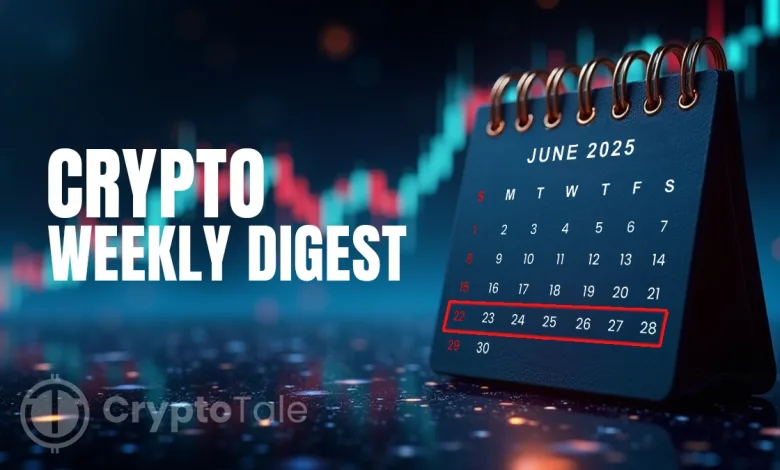The Crypto Weekly Digest, June 30: Schiff Introduces COIN Act To End Trump’s Crypto Profits

Hey folks! Welcome once again to this week’s Crypto Weekly Digest, where we bring you well-rounded latest insights. The digital asset world is heating up, and this week has delivered a perfect storm of politics, regulation, market momentum, and bold institutional moves.
Senator Schiff’s COIN Act
An emotionally charged move unfolded on Capitol Hill as Senator Adam Schiff, joined by nine Democratic lawmakers, introduced the COIN Act. The bill seeks to halt undisclosed crypto profits among public officials. The legislation follows revelations of former President Donald Trump’s $57.4 million earnings from World Liberty Financial, a crypto firm launched by his family. Schiff warns the act is vital to prevent officials from using their power for personal digital asset gain.
Texas Approves State-Backed Bitcoin Reserve
Governor Greg Abbott signed Senate Bill 21 into law, creating the Texas Strategic Bitcoin Reserve. The state now becomes the third in the U.S. to legalize Bitcoin reserves. Unlike others, Texas has committed to build with public funds. The law enables the state to buy, hold, sell, and manage Bitcoin under a separate fund, with oversight from a crypto advisory board. This bold initiative is being framed as a hedge against inflation and economic instability.
Regulatory Updates
White House crypto czar David Sacks hinted that July may become a defining month for U.S. digital asset regulation. Two major bills—the GENIUS Act and the CLARITY Act—are gaining traction in Congress. These bills aim to streamline stablecoin issuance and clarify blockchain regulation across agencies.
In the courtroom, Judge Analisa Torres rejected a proposal from Ripple and the SEC to reduce Ripple’s penalty to $50 million and eliminate a permanent injunction. The judge emphasized that backroom deals cannot replace judicial verdicts. Ripple’s legal chief Stuart Alderoty quickly responded, saying XRP remains legally sound and that the case continues.
Turning to banking, the Federal Reserve made a major shift by eliminating the use of “reputational risk” in supervising crypto-friendly banks. The new framework focuses solely on measurable financial risk. This move follows criticism that the Fed used reputation as a tool to restrict crypto access to banking services. Now, U.S. banks may feel more confident working with digital asset firms.
Further, SEC staff met with a coalition from UC Berkeley, Georgetown, and University of Chicago law schools, joined by Placeholder VC. They called for clear definitions, caps on returns, and better investor disclosures for crypto staking. The dialogue followed a May bulletin confirming that most non-custodial staking doesn’t need registration. Regulators are reviewing proposals, which could signal future rulemaking.
Internationally, South Korea’s central bank is cautiously assessing stablecoin adoption. Officials say they want innovation, but not at the cost of financial stability. This balance reflects rising global concerns over the integration of digital assets into national economies.
Related: Eric Balchunas Says, “Private Credits Are Deathly Afraid of An Actual Market”
Institutional Moves
Coinbase (COIN) surged past $350 for the first time since 2022, gaining 14.6% in just one week. The move sparked a shift in perception—from a crypto exchange to a serious financial player. Cathie Wood, head of ARK Invest, even suggested that Bitcoin holders could soon use Coinbase to secure mortgages using crypto as collateral.
Meanwhile, crypto infrastructure firm Bakkt has filed a $1 billion shelf registration with the SEC. The plan includes potential acquisitions of Bitcoin and other digital assets. This filing follows an internal investment policy change, now allowing Bakkt to hold crypto in its treasury. Though no purchases have been made yet, the move signals a strategic shift.
In Europe, London-listed Bluebird Mining Ventures secured £2 million to shift its gold profits into Bitcoin. With £1 million immediately available, the firm would use these funds to start holding Bitcoin as a long-term reserve. A debt-to-equity option is also included, giving lenders a stake in Bluebird’s future. This comes alongside a new profit-sharing deal from their Philippine operations.
In Asia, GF Securities released tokenized bonds in three currencies—USD, HKD, and offshore yuan—via HashKey. The move marks a key milestone in tokenizing real-world assets. Hong Kong continues positioning itself as a digital finance hub, embracing tokenization to support broader financial innovation.
On the corporate front, Michael Saylor teased another Bitcoin buy. The Strategy chairman posted a portfolio update showing $64.28 billion in BTC holdings—typically a precursor to fresh purchases. On June 22, MicroStrategy added 245 BTC, and all signs point to more accumulation ahead.
Related: Ethereum’s Buterin Proposes Pluralistic IDs for Web3 Privacy
In ETF news, REX Shares is preparing to launch the first Solana staking ETF. The fund structure bypasses standard 19b-4 rules and uses a unique C-corp model. Analysts say the SEC now seems comfortable with it, and launch could come soon. This will give investors exposure to Solana along with native staking rewards.
Market Overview
After a tense geopolitical conflict, U.S. President Donald Trump announced a ceasefire agreement between Iran and Israel on June 24th. The following day—June 25, 2025—Bitcoin climbed from approximately $98,000 to over $107,000, buoyed by the surge in market optimism.
Analyst charts show that Bitcoin traces global M2 liquidity with a delay of 90 days. While M2 stretched down from $100T to $112.4T, BTC tried to catch the vibe—first $42K to $84K and then $98K to $107K. If this M2 uptrend stays intact, Bitcoin should test $150K in the upcoming months.
BTC, grew by 6% in the previous week, registering at $108,357.87, as per the data on CoinMarketCap during press time. At present, the market cap stands at $2.15 trillion.
Related: PENGU and JTO Soar: Key Factors Behind Today’s Price Gains
While Bitcoin soared, Ethereum struggled. ETH fell to $2,116, last Monday after failing to hold key support at $2,491. Technical indicators worsened, including bearish MACD crossovers and rejection from the rising wedge pattern near $2,878. The sell-off was confirmed by volume spikes and a fall through Fibonacci retracement zones, highlighting vanishing buyer strength.
The price of Ethereum rose 11 to $2,441.70, recovering from a weekly low of $2,183.31. The market cap of ETH was back up to $301.66 billion, as trading volumes held steady. Both assets maintained much of their momentum this week; hence, this development must have triggered positive investor sentiment and robust technical recovery patterns across critical support levels after the recent market pullback.





